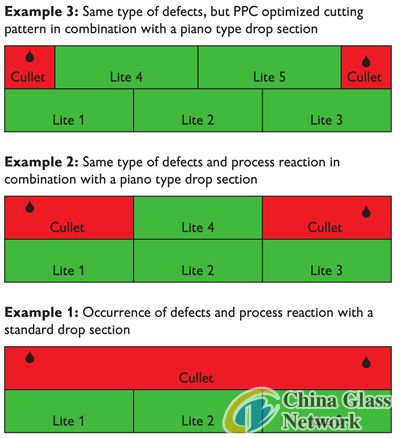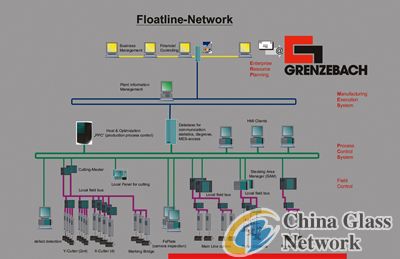Post Time:Dec 24,2010Classify:Company NewsView:1599
Grenzebach is a key supplier of processing equipment, control technology, specialist cutting, stacking and handling systems, complete manufacturing lines and cold end equipment for float glass production.

More recently the company has also focused on process technology and manufacturing equipment for the emerging thin film, photovoltaics and concentrated solar power market.
In flat glass production, optimized and order-related glass cutting performs a critical function at the cold end of the production line. This optimization directly influences the maximum yield achievable in glass production.
The basic principle of function consists of fixed and variable information concerning the production equipment. Thus, the optimization system receives order data on the type, quality and quantity of the required product either via manual operator input or from an overriding production planning system. These set-point inputs are compared to the available defect-related quality of the glass ribbon and the highest-yield cut is then calculated according to a complex algorithm. The optimization process significantly depends on status information provided by the production line regarding the capacity utilization of the transport section and the availability of the selected stacking destinations. The illustration „float line network“ demonstrates the central integration of the supervisory control and optimization system PPC into the overall network.
The Grenzebach supervisory control and optimization system, called PPC Production Process Control, is primarily the basis of the functions Optimization, Administration and Process Data Visualization. The administrative part is responsible for job management, data handling of sheet information, stacker status and their respective loading administration, diagnostics and statistics, protocols, label printing as well as communication with overriding systems such as ERP or the plant computer system.

The optimization system within the PPC calculates the optimized glass cutting, taking into consideration such factors as glass defect data, glass thickness, the position of the glass ribbon, availability of cutting tools, conveying sections and stacker destinations.. Furthermore, the system also manages optional additional tools, such as a defect marking bridge, logo and bar-code printers using the optimization system.
Visualization generates process images of the complete cold end, as well as detailed representations of the defective glass ribbon and the optimized cutting.
For glass ribbon cutting Grenzebach forsees 5 different levels of software product:
The FNC Manager provides the simplest type of cutting with restricted job management and without optimization algorithms.
The EasyOpt comprises the FNC Manager in combination with short-distance optimization and the possibility to connect a glass defect scanner.
Cut-To-Size optimization, called CTS-Opt, is already a fully fledged defect and order based cutting optimization, which operates without check-backs from the stacker or the line.
In the configuration level CTS-Opt+, the Cut-to-size optimization is extended to include the availability of production and cullet statistics.
The highest available level is PPC, Production Process Control. It provides the possibility to take line parameters such as cycle times, jam and buffering options, availability of the stacker destinations, alternative destinations and unplanned events into consideration. The PPC optimization also offers the highest level of line extension and a cut-to-size synoptic with representation of all single sheets displaying panel ID and the respective stacker destinations.

The modular programme structure provides a significant number of add-on modules in addition to the basis software. Worth mentioning is the automotive module whereby an automotive glass sheet is optimized during cutting based on defined visible areas. The function of the controlled defect density within a glass pack provides many additional advantages. Thus, the quality criteria valid for a single sheet are respected equally as well as the criteria of the maximum possible density of a complete, stacked glass pack. Detailed protocols and statistics are available for evaluation of the production numbers and proof of quality assurance.
With immediate effect, Grenzebach introduces a new patent-registered achievement with the possibility of additional yield increase.
As a result of this new development it will be possible, for the first time ever, to snap a cullet strip directly at the main snap roll with a length which can be reduced to a minimum of 200 mm over the glass ribbon width and which can be disposed of there at the same time. This will avoid a huge amount of glass loss compared to the procedure used thus far, where a 600-mm-strip was snapped and transported towards the next crusher. This new technology has been implemented into the PPC program and in combination with mechanics, control system and optimization software it achieves a significant yield increase which cannot be overlooked.
Following successfully completed practical tests, this new development is already being used for current orders.
Another way of minimizing glass loss is the combination of optimization software with an existing piano type drop conveyor. Using the piano conveyor it is generally possible to evacuate possible defective single sheets from a cap. For example, if there is an order for 3 single sheets per cap and the glass ribbon shows defects on the left and right edge, the whole cap or at least the two outer sheets would have to be removed and only the centre sheet could be stacked. By means of the optimization algorithm of the PPC, 2 single sheets will be provided for the centre of the glass ribbon and one left and one right edge strip will be cut. As a result, one or two more sheets can be produced and thus the cap yield will be increased from 33% up to 66%. (see illustration)
A further new development will be available soon offering an offline version of Grenzebach’s optimization software. As a result glass cutting will be simulated and optimized offline using a standard PC. The resulting data will then be available for process optimization and planning.
For more than 23 years Grenzebach has successfully developed optimization systems for the glass and building material production. During this time, more than 150 systems have been set into operation, world-wide. Grenzebach’s high-level language department consists of 10 software and system engineers.
Source: Grenzebach Maschinenbau GmbHAuthor: shangyi